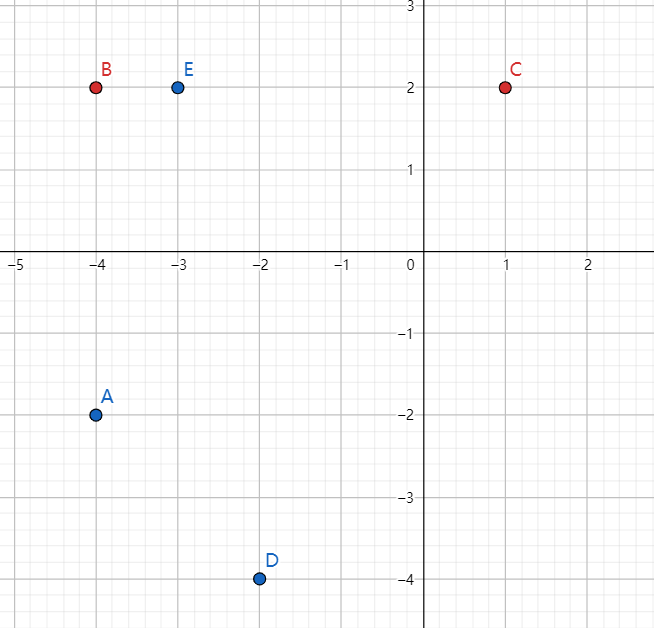1
2
3
4
5
6
7
8
9
10
11
12
13
14
15
16
17
18
19
20
21
22
23
24
25
26
27
28
29
30
31
32
33
34
35
36
37
38
39
40
41
42
43
44
45
46
47
48
49
50
51
52
53
54
55
56
57
58
59
60
61
62
63
64
65
66
67
68
69
70
71
72
73
74
75
76
77
78
79
80
81
82
83
84
85
86
87
88
89
90
91
92
93
94
95
96
97
98
99
100
101
102
103
104
105
106
107
108
109
110
111
112
113
114
115
116
117
118
119
120
121
122
123
124
125
| #include <bits/stdc++.h>
#define maxn 800005
#define int long long
using namespace std;
const long long eps = 0;
template<typename T> struct TPoint{
T x, y;
int color;
TPoint(){}
TPoint(T _x, T _y){ x = _x; y = _y; }
TPoint(T _x, T _y, int c){ x = _x; y = _y; color = c; }
TPoint(TPoint p, int _c){ x = p.x; y = p.y; color = _c; }
friend TPoint operator +(const TPoint &a, const TPoint &b){
return TPoint(a.x + b.x, a.y + b.y);
}
friend TPoint operator -(const TPoint &a, const TPoint &b){
return TPoint(a.x - b.x, a.y - b.y);
}
friend double operator *(const TPoint &a, const TPoint &b){
return a.x * b.x + a.y * b.y;
}
friend double operator ^(const TPoint &a, const TPoint &b){
return a.x * b.y - a.y * b.x;
}
friend bool operator ==(const TPoint &a, const TPoint &b){
return abs(a.x - b.x) <= eps && abs(a.y - b.y) <= eps;
}
T len2(){
return x * x + y * y;
}
T angle(){
return atan2(y, x);
}
int toleft(const TPoint &a){
auto t = (*this) ^ a;
return (t > eps) - (t < -eps);
}
void print(){
cout << "[Point] " << x << " " << y << " " << color << '\n';
}
}; using Point = TPoint<long long>;
bool argcmpC(const Point &a, const Point &b){
auto Quad = [](const Point &a){
if(a.y < -eps) return 1;
if(a.y > +eps) return 4;
if(a.x < -eps) return 5;
if(a.x > +eps) return 3;
return 2;
};
int qa = Quad(a), qb = Quad(b);
if(qa != qb) return qa < qb;
auto cross = (a ^ b);
return cross > eps;
}
int t, n, ans, sW, sB;
Point P[maxn], Basic;
vector<pair<Point, array<int, 2>>> trans(vector<Point> &P){
map<Point, array<int, 2>, decltype(&argcmpC)> uni{&argcmpC};
vector<pair<Point, array<int, 2>>> res;
for(auto x : P) uni[x][x.color]++;
for(auto x : uni) res.push_back(x);
return res;
}
int solve(vector<Point> &P, Point &B){
int cntL[2] = {}, ans = 0;
vector<pair<Point, array<int, 2>>> uP = trans(P);
int siz = uP.size();
uP.insert(uP.end(), uP.begin(), uP.end());
int l = 0, r = 0;
while(l < siz){
if(l > 0 && uP[l - 1].first.toleft(uP[l].first) == 1){
cntL[0] -= uP[l].second[0];
cntL[1] -= uP[l].second[1];
}
while(r < uP.size() && (l == r || uP[l].first.toleft(uP[r].first) == 1)){
if(l != r){
cntL[0] += uP[r].second[0];
cntL[1] += uP[r].second[1];
}
r++;
}
int cntR[2] = {}, cntO[2] = {};
cntO[B.color]++;
cntO[0] += uP[l].second[0];
cntO[1] += uP[l].second[1];
if(r < uP.size() && !(uP[l].first == uP[r].first) && uP[l].first.toleft(uP[r].first) == 0){
cntO[0] += uP[r].second[0];
cntO[1] += uP[r].second[1];
}
cntR[0] = sW - cntL[0] - cntO[0];
cntR[1] = sB - cntL[1] - cntO[1];
int bas = cntO[0] + cntO[1];
ans = max({ans, bas + cntL[0] + cntR[1], bas + cntL[1] + cntR[0]});
l++;
}
return ans;
}
signed main(void)
{
while(cin >> n && n)
{
sW = sB = ans = 0;
for(int i = 1; i <= n; i++){
int x, y, c;
cin >> P[i].x >> P[i].y >> P[i].color;
P[i].color == 1 ? sB++ : sW++;
}
for(int i = 1; i <= n; i++){
Basic = P[i];
vector<Point> np;
for(int j = 1; j <= n; j++){
if(i != j){
np.push_back(Point(P[j] - Basic, P[j].color));
}
}
ans = max(ans, solve(np, Basic));
}
cout << ans << '\n';
}
return 0;
}
|
